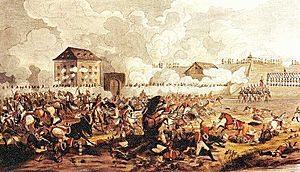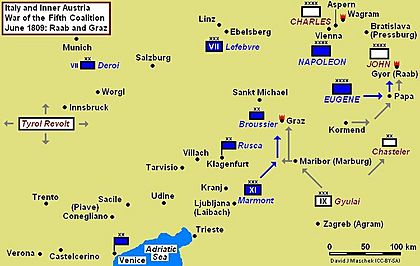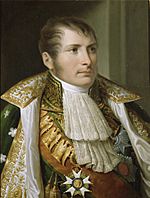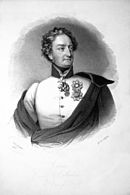Battle of Raab facts for kids
Quick facts for kids Battle of Raab |
|||||||
|---|---|---|---|---|---|---|---|
| Part of War of the Fifth Coalition | |||||||
 Battle of Raab by Eduard Kaiser |
|||||||
|
|||||||
| Belligerents | |||||||
| Commanders and leaders | |||||||
| Strength | |||||||
| 35,000–40,100 42 guns |
35,525–40,000 30 guns |
||||||
| Casualties and losses | |||||||
| 3,000–4,000 | 10,300 | ||||||
The Battle of Raab, also known as the Battle of Győr, was a major fight during the Napoleonic Wars. It happened on June 14, 1809, near the city of Győr in the Kingdom of Hungary. This battle was between the armies of France and Italy, led by Prince Eugène de Beauharnais, and the Austrian and Hungarian forces, led by Archduke John of Austria.
The battle ended with a victory for the French and Italian armies. This win was very important because it stopped Archduke John from joining his forces with the main Austrian army at the Battle of Wagram. Instead, Prince Eugène's army was able to meet up with Emperor Napoleon in Vienna just in time for the Battle of Wagram. Napoleon himself called the Battle of Raab "a granddaughter of Marengo and Friedland" because it took place on the anniversary of those two famous battles.
Contents
The 1809 Campaign in Italy
Early Battles and Retreats
The 1809 war started with fighting in Italy. Prince Eugène de Beauharnais led the French and Italian army. On the other side, Archduke John of Austria commanded the Austrian army. Early in the war, Archduke John quickly defeated Eugène at the Battle of Sacile on April 16. This forced Eugène's army to retreat.
The fighting then slowed down for a few weeks. Meanwhile, another Austrian force trapped a French army group in Dalmatia. After Napoleon's army defeated the Austrians at the Battle of Eckmühl, Archduke John was ordered to pull his troops back. This was to protect the main Austrian army's side in southern Germany.
Austrian Army's Retreat Across Europe
Archduke John fought a tough battle against Eugène at the Piave River on May 8. Up to this point, John and his soldiers had fought well. However, John then made a mistake by splitting his army into smaller groups.
He retreated northeast with his main army. Other parts of his army were spread out in different locations. Some were in Tarvis, others near Villach, and a large group was in the Laibach area. Another group was near Innsbruck, and a division was in Salzburg. A smaller force continued to fight the French in Dalmatia. Many of John's soldiers were new recruits, called Landwehr infantry, who were not as well-trained.
On May 13, a French and Bavarian army defeated part of the Austrian forces near Innsbruck. On May 17, Archduke John received orders to move north to cut off Napoleon's main army. But he waited too long. A French army group cut off and defeated the Austrian Northern Division on May 25. John then retreated towards Graz. When he heard about the defeat, he decided to move his army east into Hungary.
During May, small Austrian forces bravely defended mountain passes. At Malborghetto Valbruna, 400 soldiers held out against 15,000 French for two days. Only 50 Austrians survived. At the Predil Pass, 250 Austrians fought off 8,500 French soldiers for three days. All the Austrian defenders were killed.
In mid-May, the French army in Dalmatia defeated the Austrian forces there. They then marched north, reaching Laibach on June 3. This French force later joined Napoleon near Vienna and fought at the Battle of Wagram.
Archduke John's army met up with Hungarian volunteer forces, called the Insurrection, at Győr (Raab). John planned to cross the Danube River and move northwest to join his brother, Archduke Charles, Duke of Teschen, who commanded the main Austrian army. Napoleon ordered Eugène to chase John's army. The French and Italian troops caught up with the Austrians in mid-June, forcing John to fight.
The Battle of Raab
Armies and Their Leaders
The French and Italian army, led by Prince Eugène de Beauharnais, had about 40,000 soldiers and 42 cannons. It was made up of several army corps and cavalry units.
- VI Corps: Led by General Paul Grenier.
- XII Corps: Led by General Louis Baraguey d'Hilliers.
- Cavalry Reserve: Led by General Emmanuel Grouchy.
- Reserve: Commanded by Eugène himself, including Italian Guard troops.
The Austro-Hungarian army, led by Archduke John of Austria and Archduke Joseph, Palatine of Hungary, had about 35,500 soldiers and 30 cannons.
- Left Flank: Cavalry led by General Daniel Mécsery.
- Center: Infantry led by General Hieronymus Colloredo-Mansfeld.
- Right Flank: Infantry led by General Franjo Jelačić.
- Reserve: Led by General Johann Frimont.
- North of Raab River: Hungarian militia led by General Paul Davidovich.
Even though John's army was almost as big as Eugène's, his soldiers were not as well-trained. Many thousands were new Austrian Landwehr (local defense forces) and Hungarian Insurrection militia. Archduke John knew this, so he planned to fight a defensive battle from a strong position.
Battlefield and Plans
Archduke John set up his army behind a stream called the Pándzsa, which flowed into the Raab River. The Raab River itself protected his northern side. John hoped the marshy areas to the south would stop the French from going around his army. A strong farm, Kis-Megyer, was on the east side of the Pándzsa. East of the farm was Szabadhegy hill.
John placed his cavalry on his left side, behind the Pándzsa. He made Kis-Megyer farm a very strong point, filling it with infantry. His right side was defended by soldiers near Szabadhegy hamlet. His reserve troops were on Szabadhegy hill. Some Hungarian militia defended works on the north side of the Raab River.
Eugène put his cavalry, led by General Grouchy, on his right (south) side. Their goal was to go around John's left side. Eugène ordered General Grenier to attack the Austrian center. General d'Hilliers was told to attack the Austrian right. Eugène kept some troops in reserve, including the Italian Guards.
The Fighting Begins
At first, French troops stormed across the Pándzsa and took Kis-Megyer farm. But the Austrians quickly fought back and took it again. The farm changed hands five times in fierce fighting. The Austrians then pushed back the French, who had to retreat to the west side of the Pándzsa.
General Grouchy noticed that three Austrian cannons were guarding the best place to cross the Pándzsa. He brought up his own 12 cannons, which quickly silenced the Austrian guns. This allowed Grouchy's cavalry to cross the stream. When the French cavalry charged, the Hungarian volunteer cavalry quickly ran away. Only two regular Hungarian Hussar regiments fought bravely, but they suffered heavy losses. Grouchy then turned his cavalry to the left, starting to roll up John's left side.
Facing this danger, Archduke John changed his army's position. His right side still faced the Pándzsa, but at Kis-Megyer farm, his line bent to face south along Szabadhegy hill. He moved cavalry to cover this new left side. For his second attack, Eugène sent in fresh troops from his reserve, including the Italian Guards. This new infantry attack slowly pushed forward. Finally, the Italian Guard cleared Kis-Megyer farm. John, worried about being surrounded by Grouchy's cavalry, ordered a retreat northeast into the Győr fortress.
Outcome of the Battle
The French and Italian armies had about 3,000 to 4,000 soldiers killed or wounded. The Austrian regular troops and Landwehr lost about 4,900 soldiers killed, wounded, or captured. An additional 1,300 soldiers were reported missing. The Hungarian volunteer troops lost over 4,100 men, with most of them missing. In total, the Austrian forces lost about 10,300 soldiers.
Archduke John's army retreated northeast to Komárno. He left a small group of soldiers to defend the Győr fortress. The fortress surrendered on June 22, with 2,500 soldiers, after only a short fight.
This defeat was a big blow to Archduke John. It meant he could not bring many soldiers to help his brother, Archduke Charles, in the huge Battle of Wagram on July 5 and 6. Prince Eugène, however, was able to join Napoleon with 23,000 soldiers, who then fought at Wagram. Archduke John could only bring 12,000 men to Wagram, and they arrived too late to make a difference.
See also
- Battle of Sacile 16 April 1809
- Battle of Piave River 8 May 1809
- Battle of Wagram 5–6 July 1809
Images for kids






